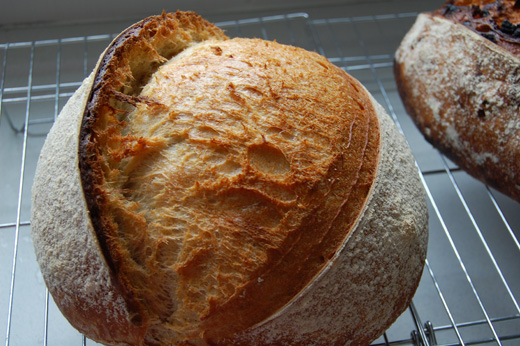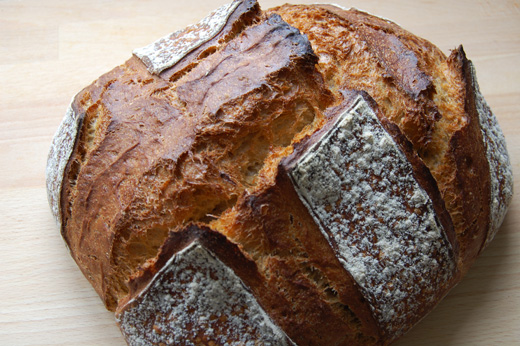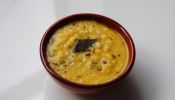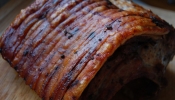The selection of breads above and below came from a stoneground mill bakery. I apologise now for the poor quality of the photos, it’s not my intent to make this bread appear inferior to prove a point, originally I didn’t plan to write about it and the camera photos were only for record keeping. I would point out appearance can be deceiving and the look of a loaf will tell you nothing about its flavour, although one can judge crust and crumb quality to some extent. I wish I could tell you the sourdough (white loaf in the middle) may not appear the most attractive sourdough in the world but it tasted heavenly, I really do.
A couple of days after buying this bread I used the same flour bought at the mill to make my own loaves to see if the flour was at fault, did this flour lack flavour? The point of white stoneground flour is the superior flavour over white roller mill flour, how can a baker bake the flavour out of stoneground? And how can he produce such a white looking crumb from stoneground flour?
Oxidising & Loss of Flavour
In April I wrote a post here on oxidising flour and the problems of over-oxidising dough from over-mixing which leads to loss of flavour.
Ageing fresh flour enabling it to oxidise helps to strengthen the gluten forming proteins, if the stoneground flour gets too old however it does lose flavour as it ages and its darker pigmentation changes to producing a paler crumb. This chemical reaction can also happen by over-mixing dough leading to over-oxidising. Bakers today love mixing…oh they love mixing their dough to death, I’ve seen it. One of the reasons high gluteness flour is beloved by many is because it’s forgiving from over-mixing, and I guess this is not so much of a problem with the tasteless white roller mill flour.
Below are my loaves I baked in April for the post I mention, both loaves using the same flour but different ages. It’s difficult to see in the photo but the older flour is at the back, a paler loaf with paler crumb, along with loss of colour comes loss of flavour.
The balance with white stoneground flour for me is using it with some ageing for strengthening the proteins, but just before it starts to lose too much flavour, about 2 months after milling.
Sourdough With No Flavour
Going back to this sourdough from the stoneground mill bakery (below), firstly it was no sourdough that I recognise, the characteristic of a nice texture slightly chewy crumb wasn’t there at all, the crumb had the softness of a fluffy yeast loaf. OK why not produce a soft crumb sourdough, each to their own.
I think this loaf was a hybrid but that shouldn’t matter, there are good hybrid crumb such as the ones Roland Feuillas produces in France, and in fact, as I’ve shown in my pouliche posts you can produce a sourdough-like crumb with a yeast dough, post here and here.
This sourdough had no flavour. I don’t like a sour tasting loaves, especially when using stoneground in order to let the flavour of the flour come through, I’ll add sourness if baking for others who appreciated it but I would welcome sourness here, it would at least taste of something. No…no sour-dough, no stoneground flavour, no crust flavour, no sourdough texture, quite honestly I’ve tasted far far better supermarket yeast loaves in Waitrose.
How Does a Baker Take Flavour Out of a Stoneground Loaf?
I was curious to find out the flavour of this mill’s flour. The slices below are mine, as you can clearly see the flour has produce the typical beige crumb I expect from a white stoneground flour, and the flavour was good. It had flavour.
My deep suspicion seeing what this flour can produce is that this baker is over-mixing the flavour out of his dough.
This mill’s flour is made from a mixed variety of English wheat and a third from foreign very strong wheat producing the strongest stoneground flour I’ve used. I’m so accustom dealing with lower protein flours with their need for support when the dough is rising that I was taken aback by this dough holding its shape unsupported on the baking sheet, over-night in the fridge without turning into an omelette shape.
I was told the foreign flour had to be blended into the mix to make the baker happy. This is why I suspect the problem lies with over-mixing.
The 100% rye loaf made at this bakery was gummy like so many ryes I’ve tasted.
The yeast loaf below had some maize flour which gave it a very pleasant flavour, interestingly enough it had the same soft texture as the sourdough loaf.
If you’re wondering what the thing in the foil is that looks like unbaked dough, it’s olive bread, it tasted better than it looked.
I counted near enough 20 different style of loaves and bakes all made by this one baker, and what came to mind was the good advice Paul Merry gave for my bakery when I worked with him last year, “make a few different style loaves, say no more than 6-8, because then you can produce quality, you can always change a daily loaf to bring in variety”. Less is definitely more in this case.
Below are my two loaves made with this mill’s flour. Good tasting flour.
There was a good discussion on UNIVERSALBREAD facebook page on the subject of white bread started by author Jim Chavallier here
The comment I made there on my experience of stoneground flour and whiteness was the following:
“On the discussion of whiteness of stoneground flour, the stoneground flour I use produces a dark colour crumb. Other stoneground flours I have experimented with also produce a dark crumb. Roland Feuillas flour produces a dark crumb. The only time I’ve seen white stoneground flour produce a “whiter” crumb which is still relatively darker to today’s rollermill flour is when it’s aged.
I’ve seen and experienced stoneground aged between 1 day after milling to over a year. The dark crumb it produces is a source of discontent among some bakers here because they fret that their loaves are not white enough for their customers. Inevitably what happens is that the mills age the flour in order to produce a whiter flour at the cost of flavour. My miller Anne Parry at Felin Ganol has sent me her flour 2 weeks after milling and I have been able to see the process of aging myself and have felt the power oxidation has on a low protein flour of 10.5% with 2 months of storage. I have also seen the flour whiten as it ages near 5 months along with loss of some flavour.”


































{ 7 comments… read them below or add one }
Hi Azelia
I’m sure you must have mentioned it already somewhere in previous posts but, here it goes, a few questions on your home baking techniques:
1. do you use a stand mixer with the dough hook or do you always knead by hand?
2. What kind of oven do you use?
THank you!
Great looking bread btw!
hi Ines – I don’t knead, but use the folding technique, have a look at the photos in these posts
http://www.azeliaskitchen.net/blog/how-to-make-an-easy-loaf-my-everyday-bread-with-no-kneading/
http://www.azeliaskitchen.net/blog/sourdough-problems-from-my-beginnings/
http://www.azeliaskitchen.net/blog/walnut-raisin-bread/
On the last post you’ll also see the details of the oven.
This was such an interesting post. You’ve forgotten more about bread that I’ve ever known. I have so much to learn and I come to your website like a sponge.
Glad you find it interesting Maureen, it’s good to share details.
How Does a Baker Take Flavour Out of a Stoneground Loaf?
Practice, Azélia, practice…..
You made me laugh out loud David, yes you’re right it’s certainly a talent
You’ve inspired me to make sourdough this weekend. I have a starter sittting in the fridge and I’ve neglected it lately. So thank you!